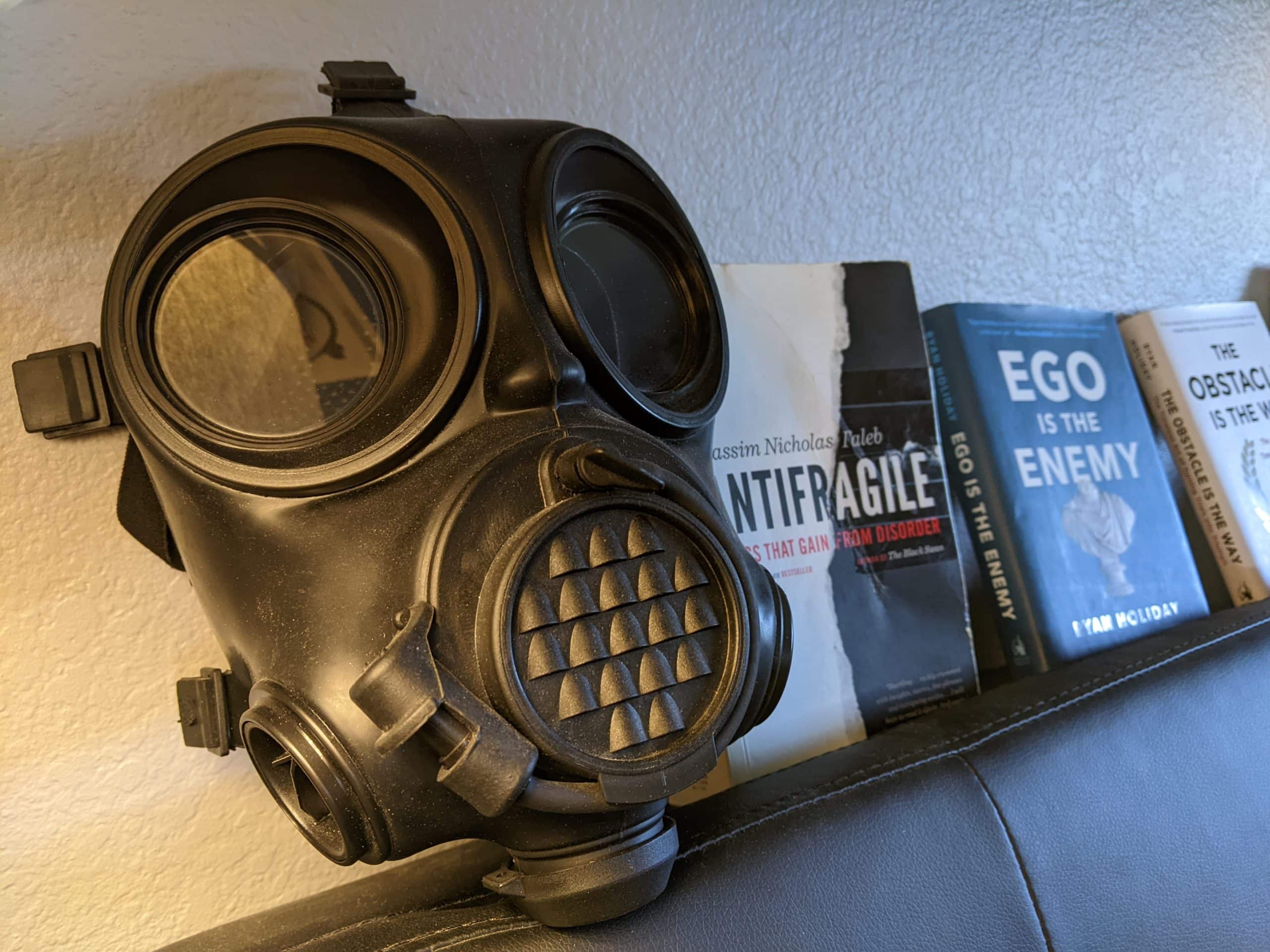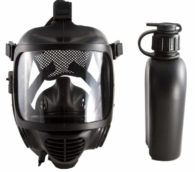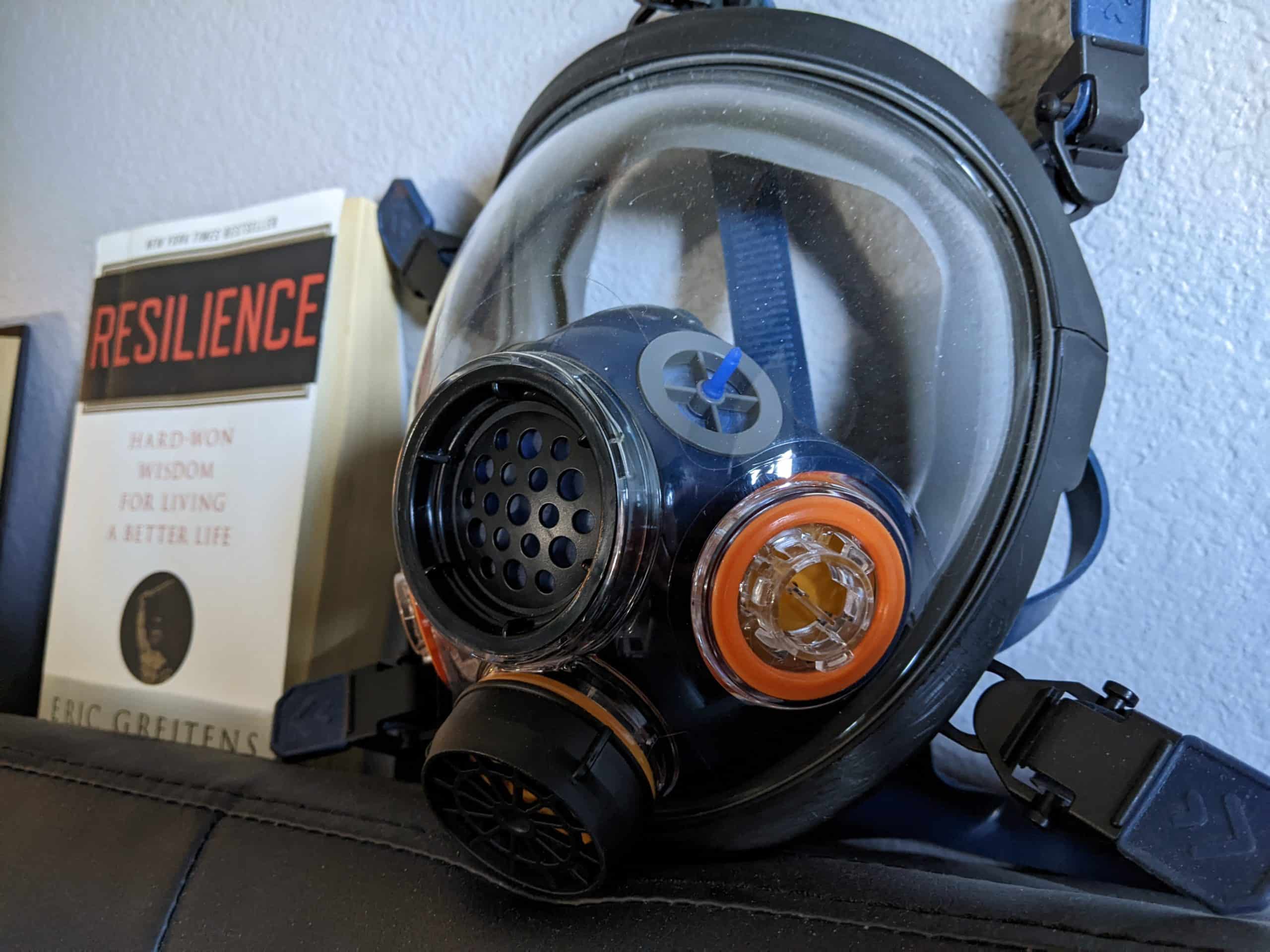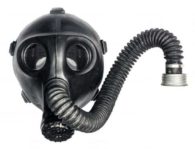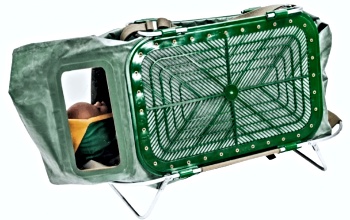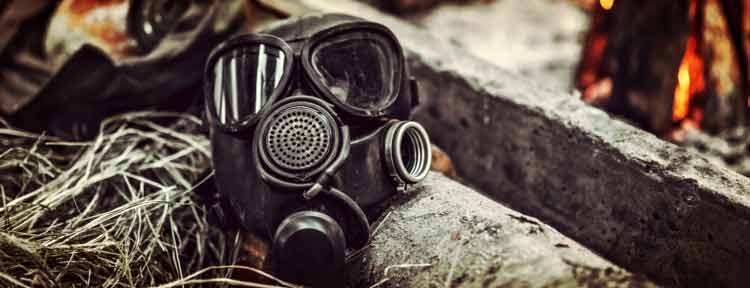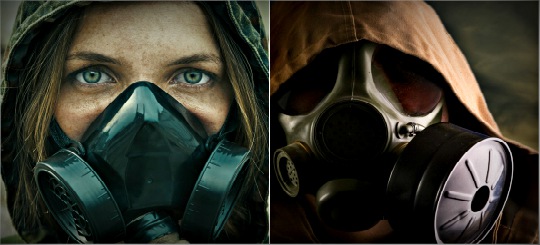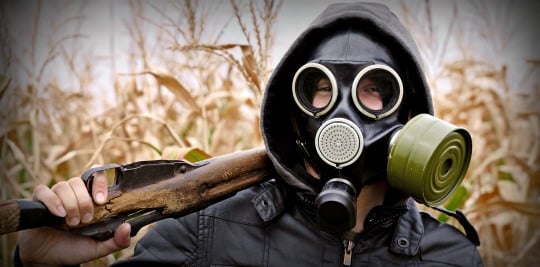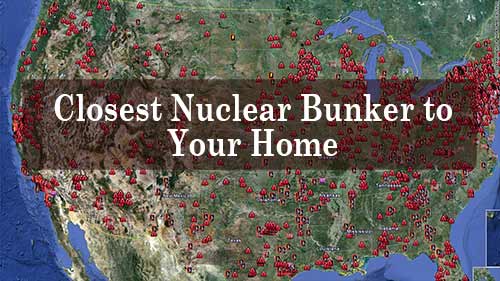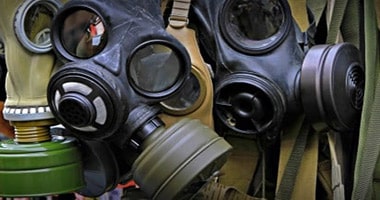
The piece of survival gear that’s always associated with chaos, war, terror, and mass destruction.
Its image conjures up thoughts and feelings of spine-chilling events. Disasters where the very air we breathe is not safe. Where the air is poison.
And that’s exactly why you need one. Because the world today is NOT on a peaceful trajectory.
But that’s not all gas masks are for…They are also necessary for many DIY projects. They can protect from paint fumes, chemical vapors, demolition debris, etc.
These are all things you should avoid breathing, which is another great reason to keep a gas mask handy. But gas masks are expensive. Some cost several hundred dollars just for the mask – filters are sold separately!
That’s why I’ve made it my mission to find the most affordable high-quality gas masks on the market today. Proven gas masks that won’t break the bank.
So today we’ll be focusing on how to find a high-quality affordable gas mask:
Note: Scroll past the first 3 gas masks IF you’re looking for a Gas Mask sized for Children…
Best Gas Masks On The Market Today
We have two competing terms to deal with; best and affordable. Oftentimes in life, you get what you pay for. But sometimes, you overpay for what you get.
Our mission is to show you the best and most affordable gas masks. Some will trend more toward the best and others more towards the affordable.
We cover a range of gas mask options but have thrown out the insanely expensive ones. The key is: To decide on your budget, and your goals, and to take action today.
NOTE: Several of the gas masks we reviewed are either out of stock or no longer offered. Gas mask supplies are still very limited – so if you can find a quality mask at a price you can afford – I suggest you buy it now. If you wait until the NEXT crisis – you’ll probably be out of luck.
MIRA Safety CM-7M Military Grade Gas Mask
With a MIRA Safety CM-7M Military gas mask, you’ll protect your eyes, face, and breathing organs against:
- Nuclear Fallout
- Biological Threats
- Radiological Agents
- Chemical Gases
- Etc.
This mask also includes a drinking tube system with a free canister.
Unlike other gas masks made of regular Butyl, this emergency mask is crafted from high-quality Bromobutyl rubber.
Making it suitable to use in the temperature range from -30°C to 70°C.
This premium MIRA mask is ergonomically designed and has a wide 180° wide view visor.
It also includes a sweat drainage system and a built-in speech diaphragm.
You can even use the drinking apparatus while wearing your glasses or even a helmet.
This affordable high-end gas mask includes features you’d normally have to pay over $400 for. Making this one of the best affordable gas masks; period.
This is the Gas Mask I own and bought for myself and I love it!
I put my money where my mouth is and that’s the real reason why it’s our #1 choice.
MIRA-Safety-CM-6M-Tactical-Gas-Mask
Here’s another excellent gas mask from MIRA Safety – The CM-6M Tactical.
The biggest difference between the CM-7M and this CM-6M is the face shield design.
The 7M has dedicated eye holes while the CM-6M Tactical is a fully open face shield.
The full-face panoramic design allows for a wider viewing angle!
It also comes with a pre-installed hydration system, along with a canteen.
PD-100 N95 Gas Mask
The PD-100 N95 Gas Mask is designed to prevent 95 percent of harmful particulates from getting in when properly worn.
Making this gas mask ideal for disaster relief, emergencies, and exposure to chemical agents or industrial vapors.
The bottom line is: It’s a highly effective shield against strong odors and dangerous gases.
It’s made with high-quality silicone to ensure a clean, airtight seal on your face.
Finally, it comes with a 100% Money-Back Guarantee & 1 Year Limited Warranty.
I also own this gas mask as a backup to my primary one. It’s a bit more affordable but it’s also not quite as top-notch as my MIRA one.
Best Gas Masks For Kids
When it comes to fitting your children with a quality gas mask, your options are extremely limited. However, over the past few years, there has been a renewed focus on protecting children.
A couple of new gas masks for kids have recently been brought to the market.
Your first choice (and best choice IMO) is the:
CM-2M KIDS Tactical Gas Mask
The CM-2M KIDS Tactical Gas Mask is one of the only full-faced CBRN rating defense gas masks for kids.
It fits kids from 1.5 years to 15 years old – after that, they usually fit adult-sized gas masks.
The CM-2M Children’s Mask is available in 2 sizes:
- Size 1: Kids 1.5 to 6 years-old
- Size 2: Kids 6 to 15 years-old
It even comes with a standard speech diaphragm and is made for CBRN defense and emergency preparedness.
CM-3M CBRN Child Escape Respirator
Here we have the CM-3M CBRN Child Escape Respirator.
This expandable hood respirator deploys in a matter of seconds and can provide hours of protection for some of the youngest members of your family.
Most modern gas masks are designed for military use. But the CM-3M Child Escape Respirator is designed for small children and young teenagers.
Because children have substantially less lung capacity than adults due to their smaller size. Meaning they can struggle to draw enough air through the complex filters in today’s gas masks.
So instead of wrestling with ill-fitting kids’ face masks and straps, this unit can simply be expanded and placed over the child’s head.
Once the blower is activated, the mask will overpressurize—simultaneously ensuring the child can breathe easily and providing a natural protective barrier to keep out aerosols and dangerous threats like mustard gas.
The solution is as simple as it is robust: powered by household CR123 batteries and using standard 40 mm NATO filter cartridges.
KZD6 Enclosure / Infant Gas Mask
This KZD6 Enclosure / Infant Gas Mask is the only solution I know of for children too young for a child’s gas mask (under 18 months) or small pets.
This protective enclosure seals hermetically. Thus it provides life-saving protection from toxic contaminants, bacterial agents, and dangerous radioactive exposures.
The KZD6 is the only protective solution of its kind and is designed to protect babies and small animals:
- Children – Up to 18 months
- Pets – Less than 30 lb
As A Way To Introduce You To Skilled Survival, We’re Giving Away Our #78 Item Complete Prepper Checklist. Click Here To Get Your FREE Copy Of It.
Why Everyone Should Own A Gas Mask
In my opinion, too many survival articles begin by pointing out that water is the number one survival priority but it’s not.
I’m NOT saying that clean water isn’t essential for survival (it is), but it’s secondary to air.
Access to clean, abundant, breathable air trumps water every single time.
Why? Because while it’s a well-established fact you can only survive 3 days without water (less time in intense heat), you can only survive a few MINUTES without oxygen (and you’ll go unconscious well before that).
Most of us take clean breathable air for granted…which can be a deadly mistake.
But you might argue that “air won’t just vanish” and you’d be right. Our entire atmosphere won’t instantly vanish.
However, just because air is breathable doesn’t mean it’s not deadly.
It’s possible to breathe highly toxic chemically infused air. The sort of air where even a few small gulps and you’re headed for an early grave.
Of course, this all depends upon the actual toxin involved and its intensity, but for the worst-case scenarios, your ultimate fate will be set in stone.
What really sucks in this situation is knowingly being forced to breathe the toxins in. Because you can only hold your breath for so long.
But at the same time, each breath brings you closer to your premature demise.
In other words “damned if you do, damned if you don’t”.
So if the thought of this horrible scenario frightens you (it does for me), you should be highly motivated to invest in a high-quality gas mask.
There are reasons why the military, police departments, and firefighters all have gas masks.
They prepare and practice rushing headlong into the worst disasters to assist their communities; even if it’s a chemical or nuclear attack. They’re equipped to survive even if the air is deadly breath.
So if you’re like me, and you’re serious about preparing, then you must invest in a quality gas mask for survival.
As A Way To Introduce You To Skilled Survival, We’re Giving Away Our #78 Item Complete Prepper Checklist. Click Here To Get Your FREE Copy Of It.
How Gas Masks Work
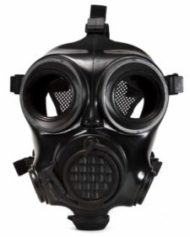
It’s an invention with one exceptionally important task – providing detoxified “clean” air.
Similar in concept to a portable water filter that cleans water prior to drinking. The key difference being you can avoid drinking water for longer than 3 minutes!
And the gas mask has been around a lot longer than you realize.
The first known gas masks were made by the ancient Greeks. They were crude versions using sponges.
A few centuries later, a pair of Iraqi brothers produced a rough prototype of a 19th-century version of the gas mask. Ever since they’ve been used by soldiers, miners, doctors, and civilians under wildly different circumstances, but always to achieve the same end goal: clean air.
But these were very primitive. They didn’t work very well, at least not well enough to ensure survival. But to be fair, chemical and nuclear warfare were still yet to be invented.
The first practical gas mask, with real survival potential, was created by a Brit named Edward Harrison in 1916 shortly after the invention of chemical warfare during WWI.
Since then the gas mask has morphed into a symbol of the apocalyptic. But as menacing as they may look; they save lives.
That is why you should add one to your survival gear in your home, or in your bug-out-bag.
But they do require research, preparation, and upkeep. And a little bit of know-how to buy the right one.
As A Way To Introduce You To Skilled Survival, We’re Giving Away Our #78 Item Complete Prepper Checklist. Click Here To Get Your FREE Copy Of It.
2 Types Of Gas Masks | Pros & Cons
The first steps to making an informed gas mask purchase are to determine which style of gas mask is right for you. And you do this by deciding what level of protection you desire.
Let’s start with the style first; you have 2 options:
1. Air Purifying Respirator
If you want a down-n-dirty, quick-n-easy, cheap solution you could buy an air-purifying respirator. But take note, these respirators only cover your nose and your mouth.
While they do technically purify the air, it leaves your eyes totally exposed.
And yes, eyeballs are extremely vulnerable to chemical damage and biological infection. And to be blunt, you need your eyesight if you want any chance to survive a real chemical attack.
Stumbling around in the dark during an attack is a recipe for failure.
2. Full Face Gas Mask
The second option is a full-face gas mask. As you probably already guessed, this version includes eye protection.
These gas masks are the ones you normally think of when someone utters the word, “gas mask”.
They include a large filter attached below the mouth area and they cover the entire face. Your eyes are inside this mask and you can see out of glass or plastic plates.
My advice? You really only have one option.
Go with the full-face gas mask.
Here’s a video showing you these different levels of respiratory protection :
As A Way To Introduce You To Skilled Survival, We’re Giving Away Our #78 Item Complete Prepper Checklist. Click Here To Get Your FREE Copy Of It.
Important Full-Face Gas Mask Options
The next most important decision to make is what type of respirator you want with your full-face gas mask.
Here we have 2 basic options to choose from:
1. Air Purifying Respirator
The first option is called an “air-purifying respirator”.
These are the most affordable and simple full-face gas masks. The filter canisters on these units are replaceable and they screw directly into the mask.
It uses the power of your lungs to pull and push air through the filter.
This setup works fairly well as long as you get can get and keep a good seal. You see, air pressure always takes the path of least resistance. As you pull air in and push air out with your lungs YOU are creating this air pressure.
Now if you have a good seal around the outside of the gas mask, then the path of least resistance is the filter itself. Which is what you want.
However, if the seal breaks or fails for any reason, the path of least resistance is no longer through the filter; it’s through the breach.
The breach route will have less resistance than the filtered route (hence the term “path of least resistance).
And that’s the one big disadvantage to this type of gas mask: any prolonged leak makes it 100% ineffective.
If there is a gap between your chin and the mask, outside air will bypass the filter and enter through the leak. And you may die.
So just make sure that seal is absolutely airtight and you’ll be just fine.
Two notes of caution here:
1) If you have a beard, you’re going to have to shave it off because facial hair makes these masks difficult to seal.
Or, you can try what this guy in the video below did with his beard. He uses Vaseline to create a seal without saving off his beard.
2) Also, be careful what tasks you are performing while in the mask. You don’t want to accidentally run into anything that could break the air seal.
So try not to be clumsy or perform any unnecessary acrobatics if you can help it.
The bottom line is even if you initially establish a good seal, you still need to be diligent enough to KEEP a good seal.
2. SCBA Masks
The second variety of masks is by far the most effective, and the heaviest. It is the type of mask that firefighters use to breathe in smoke-filled rooms. It is called the “self-contained breathing apparatus system” (or SCBA).
These masks require you to carry around a tank full of air (usually strapped to your back). But they provide the highest level of protection and security of any respirators on the market.
The tanks contain air and it keeps pumping it into the mask at a constant rate. This design keeps a positive pressure in the mask at all times, which essentially eliminates the need for a perfect seal.
Why? Because of physics. Air moves in one direction only. From high pressure to low pressure.
One simple way to understand this concept is by thinking about a flat tire. An inflated tire contains pressurized air. Or another way to explain it; it has more pressure in the tire than the surrounding atmosphere.
Hence, when you get a flat tire, the air moves from its higher-pressure environment (in the tire) to the lower-pressure atmosphere (out of the tire); never the other way around.
So a gas mask filled with pressurized air will leak out, never in. As long as the gas mask maintains a relatively higher air pressure than the surrounding atmosphere a leak is not dangerous.
Ok, enough science for one day…
But the SCBA setup is not without its trade-offs: for one, it’s bulky, heavy, and unwieldy in all circumstances. SCBA equipment is also a challenge to store in small spaces.
It takes up serious square footage in a regular-sized closet. Also, most tanks only contain about 30-60 minutes of fresh oxygen anyway and you can only refill them using special equipment.
So as you can see, there are upsides and downsides to each of your options. It is totally up to you to determine what kind of chemical or biological threat you plan to face, how much you are willing to spend, and how protected you want to be.
Bottom line:
Not all gas mask setups are equal. Some are glorified surgical masks while others are only used by serious professionals in the most dangerous circumstances.
Now at this point, I could cop out and leave it at “just do your own research” but that’s why you’re here; looking for advice. So here’s my advice.
Invest in a full-face air-purifying respirator and practice putting it on and getting a good seal.
And if you have a large and gnarly beard and refuse to part ways with it, good luck with that…
Here’s a short video covering the basics of using a full-faced gas mask.
Ok, before you pull the trigger on a purchase we still have some more technical groundwork to cover. So stay with me…
As A Way To Introduce You To Skilled Survival, We’re Giving Away Our #78 Item Complete Prepper Checklist. Click Here To Get Your FREE Copy Of It.
How A Gas Mask Filter Works
The common full-face air-purifying respirator gas mask uses filter canisters to keep the air you breathe, poison, and disease-free.
There are three general types of filter designs:
- Particle Filtration
- Chemical absorption
- Chemical reaction to neutralize other chemicals
Particle Filtration
Particle filtration is the most common and the simplest of these three options (and it’s also the oldest). Just like the ancient Greeks who held sponges up to their faces, particle filters act to block foreign substances from entering your lungs.
Recall a time when you’ve pulled your shirt over your nose in an attempt to block the smell of a particularly repulsive fart. You were employing a crude version of particle filtration.
Very fine particulate filters are helpful against biological threats, like anthrax. However, these filters have a limited life.
They can only hold so much particulate matter before they clog, so you have to replace them after every 20-24 hours of use (always verify these numbers on any gas mask filter you intend to purchase).
If you are trying to prepare for a chemical threat, then you will have to take a different approach. While particle filtration is an effective system, it does little to purify the air of chemical agents.
For that, you will need to use an activated charcoal system for chemical absorption.
Most deadly chemical warfare agents come in the form of gaseous vapors (not particulates) and will slip straight through your particle filtration filter system and kill you.
Your best bet, whether you are trying not to breathe household chemicals or a neurotoxin, is activated charcoal.
Activated Charcoal
Charcoal is a highly porous form of carbon. So porous, in fact, that it chemically attracts gaseous or liquid substances strongly enough to trap the harmful chemical vapors. But it doesn’t catch everything.
Certain chemical agents aren’t chemically attracted to carbon and will pass straight through (such as sodium and nitrates just to name a couple).
This is to say that the activated charcoal will absorb some chemical agents while totally ignoring others. Chemicals that could be as equally dangerous.
The final type of filter option uses chemical reactions to neutralize. This is a very effective way of defending against one specific chemical agent or another, but you have to know exactly what you are up against so that the respirator is loaded with the right counteractive chemical.
For instance, in WWI during chlorine attacks, soldiers would be fitted with masks containing sodium thiosulfate, which would react with, and neutralize the chlorine in the air.
When you buy these filters they are color-coded to indicate which type of gas or acid they work to diffuse.
Unfortunately, for most people, this type of mask is ineffective, because it’s impossible to predict what kind of chemical will be present in any given attack.
No matter what type of filter you end up choosing, you will have to invest regular time and money in keeping them maintained. No filter lasts forever – in fact, most only last about 20-24 hours of use.
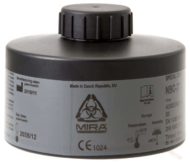
They also have a limited shelf life, so you will have to check up on them every so often and replace them once they expire (even if you did not get the chance to use them yet).
To avoid any immediate shelf-life concerns – these high-quality MIRA Filters have a 20-year shelf life!
A final note of caution: Don’t use any filters that were made during WWII or early. Back then, asbestos was considered the ideal filter medium. Now we all know that breathing asbestos is highly dangerous and will lead to asbestosis and lung cancer. You’ve been warned.
As A Way To Introduce You To Skilled Survival, We’re Giving Away Our #78 Item Complete Prepper Checklist. Click Here To Get Your FREE Copy Of It.
Final Thoughts
Here’s the rub: when it comes to any gas mask, a little late can be too late. Even the most expensive, advanced, top-of-the-line gas masks can save you if you can’t deploy them fast.
If you put your mask on after you realize there’s a life-threatening chemical in the air, you’re probably already dead.
Real-life doesn’t happen like the movies. Every second of respiratory exposure, be it biological or chemical, is a second closer to death.
It’s also impossible to tell when or where you’ll need your gas mask.
Sure, soldiers and police often get a heads up. That way they can deploy their masks quickly.
Civilians don’t get such notice.
We are at work, or in our cars, or hanging out with friends most of the time.
And should word of a chemical/biological attack reach you while you’re away from home, you’re going to wish you’d taken it with you.
The best way to avoid this is to buy several gas masks and a set of filters for each one. Then store them in various places where you often spend time.
Keep one in your car, one at the office, one at the house, one in your get home bag, and one in your bug out bag.
If there is a place you spend a lot of time, stash a gas mask nearby.
Not only does this provide peace of mind, but it also increases your chances of surviving a nuclear or chemical attack by tenfold.
Will Brendza
P.s. Do you know where the closest nuclear bunker is from your home?
There are a lot of natural nuclear shelters in the US that are absolutely free. And one of them is near your home.
Click here to see the Closest Natural Nuclear Bunker to Your Home?
Click on the image above to find out where you need to take shelter.
The post Best Survival Gas Masks (and Filters) On The Market In 2022 appeared first on Skilled Survival.



